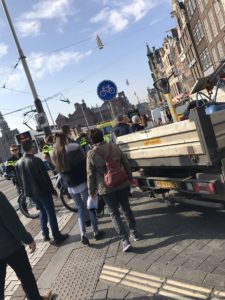Today already 30% of the commercial traffic in Dutch cities is for construction sites. Some 50% of Dutch construction turnover takes place in the major cities. That is expected to grow to 80% in the coming decades. The construction sector has been tasked with building a million new homes, making the existing housing stock sustainable and modernizing the sewage systems. Today already 30% of the commercial traffic in Dutch cities is for construction sites: more than 200,000 delivery vans and 20,000 trucks on a daily basis. This not only leads to congestion, but also to problems with air quality, noise, and traffic safety. Construction traffic is also a major emitter of CO2.
Increasing disruption due to construction demands a structural approach
Construction activities are putting the quality of life in cities under permanent pressure. In the absence of structural measures, the level of disruption for business owners, residents and visitors will increase dramatically. “Chaos is inevitable, however, and the impact will be enormous,” said an Amsterdam city council member recently at the start of a major project in the center of that city. But chaos is a choice: setting up smart construction logistics in advance will prevent most of the disruption. That will not only save money, as the Dutch logistics sector has calculated, but it will also cut CO2 emissions right in half.
Smart construction logistics pays off
More than 15% of construction costs have to do with transport to and from construction sites. The costs of failure of inefficient construction logistics are high. In recent years, the construction sector has experimented with new concepts including setting up a construction hub on the egde of town, using construction containers, introducing traffic measures and transporting goods by water.
Dutch construction companies such as TBI and VolkerWessels and transport company E. Lafeber have participated in pilot projects in Amsterdam and Utrecht together with the Netherlands Organisation for Applied Scientific Research (TNO) and various universities of applied sciences, among other partners. The results are promising: nearly 70% fewer transport movements to construction sites, nearly 70% fewer CO2 emissions, and up to 40% higher productivity at the site. In the end, 3 to 5% lower construction costs were achieved. At the same time, there were also fewer complaints from people in the surrounding area. Smart construction logistics not only benefits society, it also ensures more efficiency within the construction chain. That means investments will eventually pay for themselves.
Culture change is necessary
Despite these experiments, smart construction logistics has yet to be structurally anchored in the construction practices currently used in city centers in the Netherlands. The larger construction companies are aware of the necessary culture change aimed at long-term collaboration within the entire construction chain. Investments and returns need to be evenly distributed within that chain. In the meantime, supporting information-and-communications technology is now available that can contain the entire set of data regarding a construction process, including information for transport planning and materials management. The construction industry is ready to start; it’s the commissioning clients that are still lagging behind.
Now it’s up to the clients and municipalities
More needs to be done if smart construction logistics is to become structurally anchored. Construction logistics should become a permanent agenda item in tendering procedures and in regulations concerning accessibility, livability and safety. Tendering procedures leave room for parties to let the quality of the logistics outweigh price considerations. Within the context of the main road network, Rijkswaterstaat – the government agency responsible for the design, construction, management and maintenance of the main infrastructure facilities in the Netherlands – has already achieved a lot in this regard. Public sector clients and the larger municipalities (both as client and as permit issuer) can quickly put that experience into practice in Dutch cities.
Smaller projects require different logistics
The larger construction companies and suppliers will no doubt find their way. But for the construction logistics involved in the countless small-scale renovation projects carried out by small firms or independent contractors, a different approach is required. The question is whether the traditional practice of having hordes of contractors enter the cities in their individual vans is sustainable.
There is hope. Especially if the containers filled with the materials and tools needed for a project can be delivered in the evenings. Municipalities can encourage this by making special spaces available, such as on pontoons on the water. This idea is nothing new. Yet it could be given an extra impetus if smaller contractors would start doing this as cooperatives or if they received support from logistics service providers or wholesalers with strategically situated stock locations.
With smart construction logistics, projects will proceed more quickly, cause less disruption and require fewer people. Smart construction logistics is a driver of innovation in the construction sector. And that innovation is necessary if we are to quickly develop the structural measures we need to order to keep the areas around construction projects in major cities livable and accessible. With smart construction logistics projects will proceed more quickly, cause less disruption and involve fewer people on the construction site. And construction costs will also be 3 to 5% lower. To achieve this, all parties in the construction sector will need to work together. Smart construction logistics clearly deserves a prominent place on the Construction Agenda of the Netherlands Construction Task Force, under the leadership of Bernard Wientjes.

